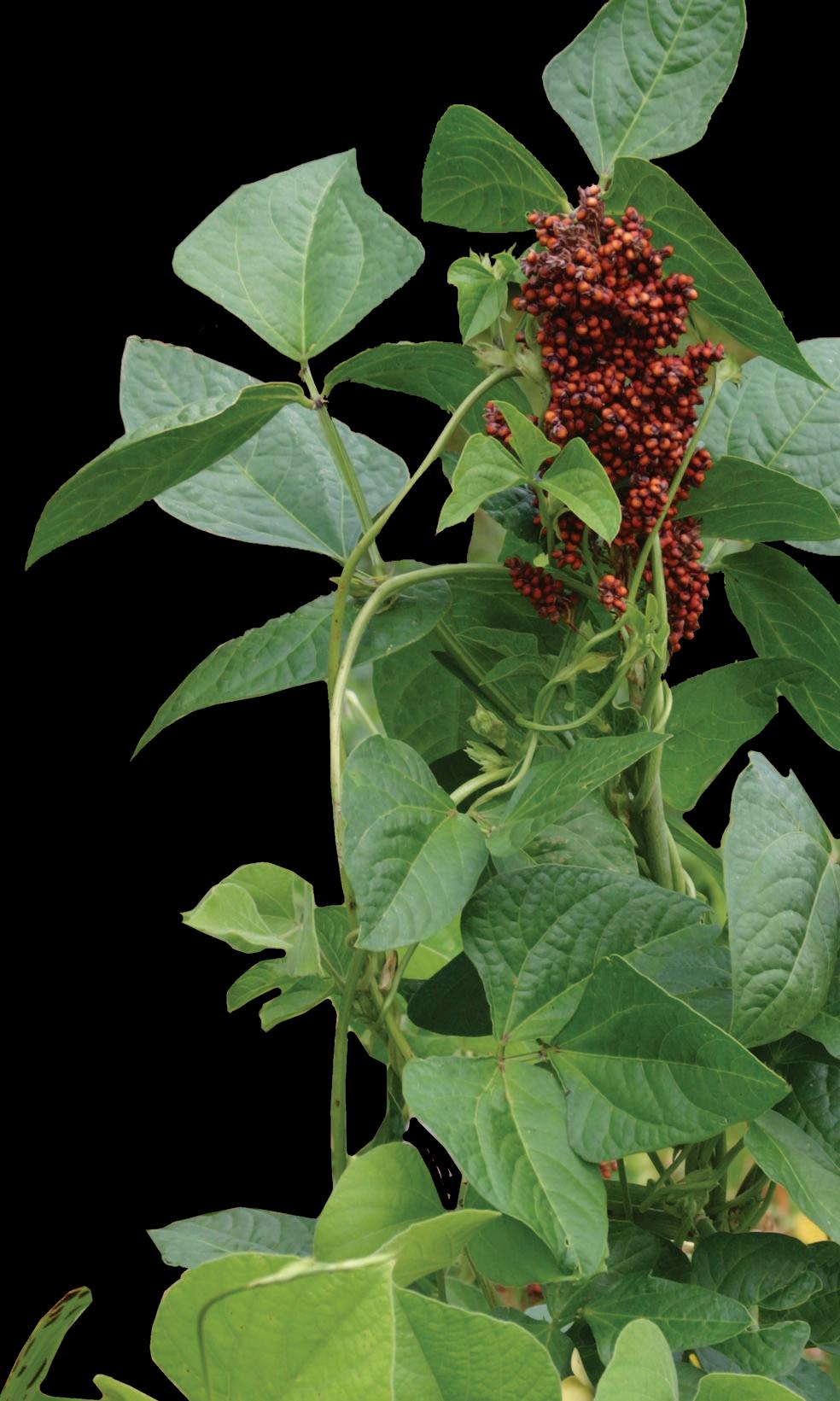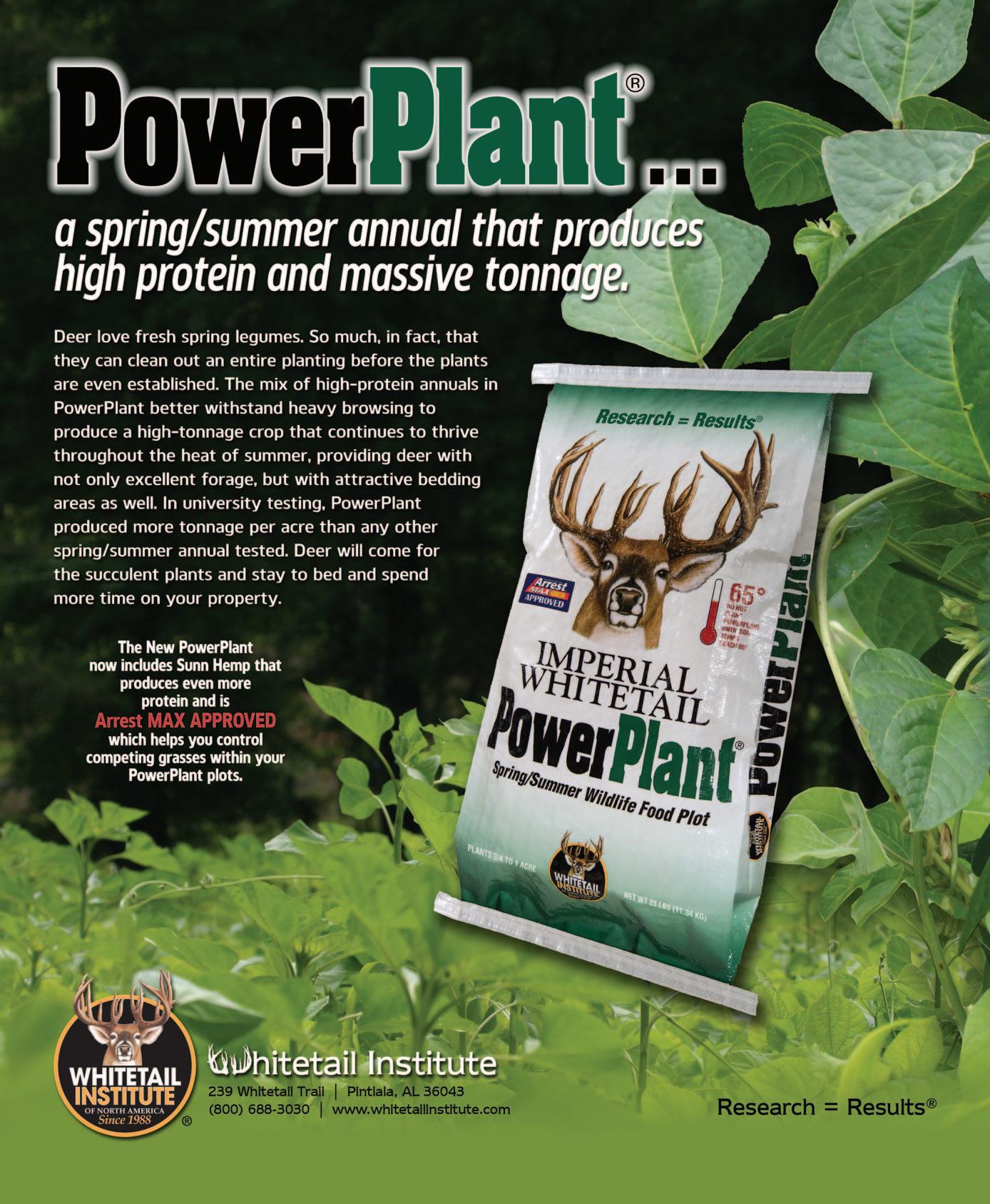
9 minute read
PowerPlant: Specifically Designed to Produce Massive Tonnage of Spring/Summer Protein for Deer
PowerPlant: Specifically Designed To Produce Massive Tonnage of Spring and Summer Protein For Deer By Jon Cooner
ny time deer nutrition of spring and summer is discussed, the
Advertisement
conversation always includes protein, and the reason is simple: protein is vital to a host of physiological processes deer go through every spring and summer. PowerPlant is specifically designed to provide massive tonnage of highprotein food for deer right when they need it most. Let’s break that down:
Protein — The Most Important Spring and Summer Nutrient. As I mentioned, deer go through lots of physiological processes that heavily depend on protein during the spring and summer. These include antler growth, doe pregnancy, doe lactation and the physical growth of all deer, including fawns. Exactly how much protein deer need during the spring and summer is a matter of some debate, but it is generally recognized that bucks require about 16% dietary protein when building their antlers, does about 18% when they’re lactating, and fawns up to 20%, some of which they get from their mothers’ milk.
Mother Nature’s Low-Protein Offerings. Mother Nature provides enough protein for deer to grow antlers and reproduce. However, she rarely provides enough protein for deer to “max out” on antler size and body weights. Compare the dietary protein needs I set out above with the protein content of most natural forages of spring and summer, which generally runs about 6-8%. Also, consider that even these meager protein sources become less available as August approaches in most areas. Even with these low protein levels and lack of availability, deer can obviously “survive,” but a manager who wants to improve deer quality as far as their genetic blueprints allow will have to supplement protein to make up for the shortfall.
And that’s exactly what PowerPlant does. In fact, no other competing food plot product the Whitetail Institute has ever tested can match PowerPlant for its tons of production of high-protein forage for deer.
PowerPlant’s “Specific Design”
to supplementing nature’s shortfalls in spring/summer protein is to plant forages that produce lots of protein, right? Well, not exactly. The reason lies in understanding something I said in the first part of this article: “PowerPlant is specifically designed to provide massive tonnage of high-protein food for deer right when they need it most.”
1. PowerPlant Delivers Abundant Protein During Spring and Summer
“Specifically Designed… for deer.” To understand why specific design is so important, consider that even the highest protein plants on earth would do deer no good if deer aren’t attracted to them. That’s why, in addition to protein production, the Whitetail Institute has taken such great care to ensure that PowerPlant exhibits two additional traits: excellent attraction, and the ability to keep producing even as deer feed on it.
2. PowerPlant is Extremely Attractive to Deer
PowerPlant is attractive to deer in two ways: as a highly palatable forage, and as a bedding area. As for high palatability, an excellent example of how PowerPlant can be more attractive to deer can be seen by comparing agricultural-type soybean plants to the vining, foragetype soybeans in PowerPlant. There’s no question that deer are attracted to agricultural soybeans and the vining, forage-type beans. However, the vining beans in PowerPlant grow as supple vines that remain tender, unlike agricultural soybeans that tend to become tougher and more stemmy (and therefore less palatable to deer) as they mature.
PowerPlant also includes Sunn Hemp, which does double duty as a second extremely attractive food source and as a lattice for the vining beans to climb and maximize production instead of growing along the ground. Small amounts of sunflowers are also included in PowerPlant to provide additional lattice.
In addition, to its excellent attractiveness to deer as a food source, deer are also readily drawn to PowerPlant as a bedding area. When you recognize the fact that PowerPlant is designed to grow into a thick mass up to 8 to 9 feet tall, you can see why PowerPlant draws deer so heavily as a bedding area, boosting its overall attractiveness even further.
3. PowerPlant is Designed to Tolerate Heavy Browsing by Deer
So far, we’ve discussed the facts that PowerPlant provides an extremely attractive, abundant, high-protein food source and a bedding area for deer. The third “specific design” characteristic that helps make PowerPlant such a superb forage for deer is its ability to withstand heavy browsing by deer once it establishes (once it reaches a height of about two feet).
Most folks who have planted stands of straight summer beans and peas before have seen first-hand how quickly deer can wipe them out. One way PowerPlant is designed to avoid this problem is due to the ability of the vining beans and Sunn Hemp to regenerate and continue to grow as deer feed on them.
PowerPlant is designed to grow vigorously until the frosts of fall arrive. After that, food production stops, and PowerPlant continues to provide cover for deer into the cold winter months.

Minimum Recommended Plot Sizes and Seeding Rates for PowerPlant Recommended Recommended Minimum Seeding Rate Plot Size Areas of Low to Average Deer Density 1 acre 25 lbs. per acre Areas of High Deer Density 1.5 acres 50 lbs. per 1.5 acres Strategic Use of PowerPlant During Hunting Season. PowerPlant’s recommended plot sizes allow you to continue to use it during hunting season. Here is a great strategy for turning your standing PowerPlant into one of the best harvest plots you can imagine. Start by determining your most common prevailing wind direction during hunting season. After you determine your prevailing wind direction during hunting season, locate a permanent stand site on the downwind corner or edge of the PowerPlant plot. Then, 3-4 weeks before the start of your fall planting window, mow lanes through the PowerPlant. Wait a few weeks for the clippings to dry, and then disk or till the clippings into the lanes, smooth the lanes with a drag or roller, and plant the lanes with an Imperial Whitetail annual such as Pure Attraction, Winter-Greens, Beets & Greens or No-Plow.
This is shown in the accompanying graphic. The bright green area represents standing PowerPlant. The red areas represent the lanes you’ll mow 3-4 weeks before your fall planting dates and later plant in an Imperial Whitetail annual.

PowerPlant provides massive amounts of antler-growing protein during the spring and summer. PowerPlant is also designed to better withstand heavy browsing.


You should put in enough lane area, but not too much. You want enough plantable lanes to keep the plot attracting deer even after frosts, when PowerPlant begins to stop producing, but you don’t want so many that you destroy the feeling of safety deer have in the tall and thick PowerPlant. Keep the lanes fairly skinny (10 to 20 feet wide is a good rule of thumb) so that deer will feel safe using the lanes during daylight hours. If you do it right, you’ll likely find that deer continue to live in the PowerPlant and step in and out of the lanes throughout the day. The fall/winter annuals planted in the lanes will make the plot an attractive source of nutrition all the way through the late season.
Final Thoughts
Don’t miss out on your opportunity to benefit from the use of PowerPlant. The Whitetail Institute has run out of PowerPlant every year since its introduction. And as more and more hunters find out how well it performs, demand for PowerPlant continues to increase significantly. In fact, PowerPlant sold out last year quicker than ever, more than two months before the planting season was even over.
PowerPlant provides a host of benefits even beyond those I’ve mentioned above. For example, other wildlife will use PowerPlant as cover for their young and can benefit from the small seeds produced by the sunflowers in PowerPlant.
PowerPlant may also be an option if you have poor soil that is less than optimum for planting a perennial like Imperial Whitetail Clover or Alfa-Rack Plus. And what if you’ve missed your spring planting dates for your favorite Imperial Whitetail perennial? In such cases, PowerPlant can be a great option for attracting and holding more deer on your property and providing them critical protein during the spring and summer until you can plant your perennials in the fall.
PowerPlant is also easy to plant. For optimum results, PowerPlant should be planted in a seedbed where soil pH is at least 6.0 and with as little weed and grass competition as possible. Start by performing a soil test. Use a professional laboratory soil test kit – one that sends soil off to a lab, and not the probe or slurry-type do-it-yourself kits, which aren’t consistently accurate. Then in early spring, add any lime recommended by your soil-test report to the surface of the plot. As soon as possible in early spring, disk the lime thoroughly in to the top few inches of soil, and smooth the seedbed with a heavy, fence-type drag. Try to do this before spring green-up if possible.
In areas subject to heavy weed and grass invasion, a great option can be to wait several weeks after spring green-up for weeds and grasses to return, and then spray the seedbed with a glyphosate herbicide such as Roundup. In many areas there are literally millions of dormant weed and grass seeds in the ground, and when you till the soil, you will almost certainly bring many to the surface where they will germinate and grow. By tilling in lime and smoothing the seedbed early before green-up, you can allow these weed and grass seeds to germinate and then control them with Roundup before planting PowerPlant. This is not a mandatory step, but remember that you will be fertilizing your PowerPlant with nitrogen fertilizer, which can also stimulate weed and grass growth, so if you are concerned that weeds and grass might compete with your PowerPlant during its early stages, spraying with Roundup before planting can be a great idea. More Great News: PowerPlant is Arrest MAX Approved. If you experience grass competition soon after planting, remember that PowerPlant is approved for spraying with the Whitetail Institute’s selective grass herbicide, Arrest MAX.
Since its introduction, PowerPlant has continued to prove itself a winner. Independent academic studies have confirmed that of the available spring/summer annuals on the market for deer, PowerPlant outperforms them all. If you are looking for a food plot product that provides massive amounts of protein and unsurpassed browse tolerance even during the hot summer months when natural forages dry up, PowerPlant is the answer. No other annual food plot planting, branded or generic, can compare. ^










